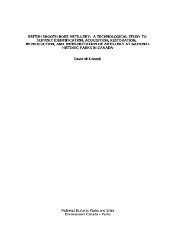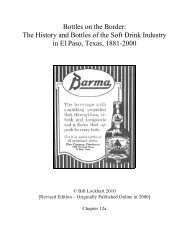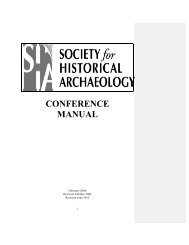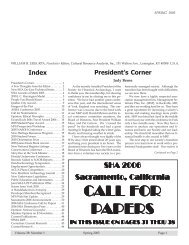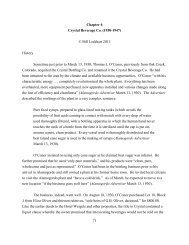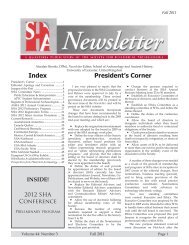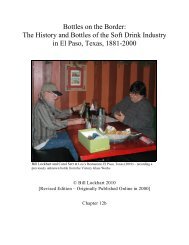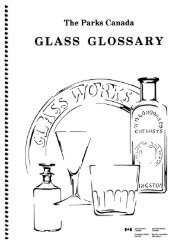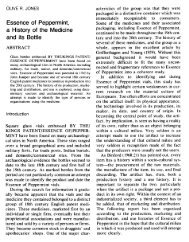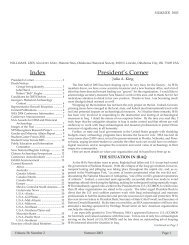Alexander Arbogast
Alexander Arbogast
Alexander Arbogast
Create successful ePaper yourself
Turn your PDF publications into a flip-book with our unique Google optimized e-Paper software.
<strong>Alexander</strong> <strong>Arbogast</strong><br />
Bill Lockhart, Beau Schriever, Bill Lindsey, and Carol Serr<br />
This little-known firm was only mentioned in passing by a few researchers. Little is<br />
known about its bottles and even less about its history. The name, location, and family<br />
connections, however, are intriguing. Three members of the <strong>Arbogast</strong> family were involved with<br />
the glass industry as manufacturers, inventors, or both.<br />
Histories<br />
<strong>Arbogast</strong> & Kappahan, Pittsburgh (1860-1861)<br />
<strong>Alexander</strong> <strong>Arbogast</strong>, Pittsburgh (1861-1863)<br />
Born in 1829, <strong>Alexander</strong> <strong>Arbogast</strong> was one of ten children of Ignatius <strong>Arbogast</strong> and<br />
Catherine Muhlbach <strong>Arbogast</strong> (Ancestry.com). He teamed up with Gustavus Kappahn (or<br />
1<br />
Kaplahn) to form the firm of <strong>Arbogast</strong> & Kappahan, listed in the city directories in 1860 and<br />
1861. At some point during 1861, Kappahn disappeared, and the only listing was for <strong>Alexander</strong><br />
<strong>Arbogast</strong>, Glass Manufacturer. Despite the listing, he also appears to have been styled A.<br />
<strong>Arbogast</strong> & Co., a name found embossed on bottle bases (Hawkins 2009:34).<br />
Van Rensselaer (1969:181) added that the firm made “dark glass schnapps bottles, porter<br />
bottles, brandy bottles and wine bottles, carboys, and demijohns.” Knittle (1927:350) only<br />
mentioned the 1860 listing. The McKearins (1941), Jones (1968), and Toulouse (1971) were all<br />
completely silent about <strong>Arbogast</strong>, although Toulouse and the McKearins mentioned the Philip<br />
<strong>Arbogast</strong> machine (see below). None of the sources mentioned a successor to the firm. <strong>Arbogast</strong><br />
died in 1872 (Ancestry.com).<br />
1<br />
Hawkins (2009:34) provided the probable first name. The directories did not directly<br />
name the Kappahn or Kaplahn who partnered with <strong>Arbogast</strong>.<br />
297
Containers and Marks<br />
Although <strong>Arbogast</strong> & Kappahan apparently failed to use a logo,<br />
<strong>Alexander</strong> <strong>Arbogast</strong> may have used three marks during his brief span in<br />
business.<br />
AA<br />
Farnsworth & Walthall (2011:57, 402-403) described and<br />
illustrated a soda bottle embossed “FRANCIS SCHONWALTD (arch) /<br />
Figure 2 – AA on heel of<br />
Schonwaltd bottle (Farnsworth<br />
& Walthall 2011:402)<br />
CHICAGO / AA (both horizontal)” –<br />
with the “AA” positioned just above the<br />
heel – a typical location for a<br />
manufacturer’s mark at that time<br />
(Figures 1 & 2). The bottle is bright<br />
blue in color (but not cobalt blue), has<br />
an improved pontil scar on the base, and<br />
has a rounded tapered finish. This is the<br />
only report we have found for this mark, but Schonwaltd was<br />
apparently only bottling mineral water during 1859 and 1860 – the timing is perfect.<br />
Figure 1 – Francis<br />
Schonwaltd bottle<br />
(Farnsworth & Walthall<br />
2011:402)<br />
A. ARBOGAST PITTS (1861-1863)<br />
Wilson (1981:113) showed this mark in his collection from<br />
Fort Union (1862-1891). It was situated in a Ricketts mold, a type<br />
of plate mold that wraps around the outside of the base of a bottle<br />
allowing embossing while the center is raised in a kick-up (Figure<br />
3). The base shown also had a dot or mamelon, common in bottles<br />
with kick-ups. The bottle is likely a “cylinder whiskey” or an<br />
earlier bottle for porter, ale, or even wine. Jones (1966:6) noted<br />
that the mark was found on “straight barrel. 3 piece mold. Also on<br />
amber whiskey type.” Glassworks Auctions provided a photo of<br />
what was almost certainly the same bottle (Figure 4).<br />
Figure 3 – A. <strong>Arbogast</strong> &<br />
Co. on Rickett’s mold<br />
(Wilson 1981:113)<br />
298
Hawkins (2009:36) added that the name was<br />
embossed on “plain and embossed black glass three-piece<br />
mold cylinder whiskies.” At least one porter and one soda<br />
bottle were also marked in a circle on a Rickett’s mold<br />
(von Mechow 2013). The mark should be dated ca. 1861-<br />
1863. Farnsworth & Walthall (2011:57, 402-403) noted<br />
two cylinder whiskey-type bottles that were found at St.<br />
Louis. Along with the “A. ARBOGAST PITTS”<br />
basemark, one of the bottles “U.S.A. / MEDICAL<br />
SUPPLIES / FROM / PIKE & KELLOG, ST. LOUIS” on<br />
the shoulder. Hawkins (2009:36) noted that these as<br />
“three-piece mold whiskey bottles such as Pike & Kellogg<br />
Medical Supplies bottles from St. Louis.”<br />
Pike & Kellogg succeeded Bacon Hyde & Co. at St.<br />
Louis by at least 1855. The firm was in turn replaced by<br />
E.C. Pike & Co. (Meyer Brothers Druggists 1918:6).<br />
Pre-pro.com (2013) only discovered Pike & Kellogg at 129<br />
N. 2nd St. in 1860, despite consulting St. Louis directories from 1859 through 1918. The firm<br />
was a wholesale whiskey dealer. Edward C. Pike and Sanford B. Kellogg sued James M.<br />
Kershaw for the sum of $93.95 on June 16, 1861(Missouri Digital Heritage 2013). The firm<br />
apparently reorganized soon thereafter.<br />
Figure 4 – A. <strong>Arbogast</strong> & Co. on<br />
cylinder whiskey bottle (Glassworks<br />
Auctions)<br />
ARBOGAST & CO. PITTS PA (1861-1863)<br />
Jones (1968:5) illustrated two examples of this mark, and another resides in the Jay<br />
Hawkins collection on a blackglass, three-piece mold whiskey bottle. The mark is embossed on<br />
a Rickett’s-type mold around the base. Although this name was never recorded in the Pittsburgh<br />
directories, it was obviously used by <strong>Arbogast</strong>, although it may actually reflect the <strong>Arbogast</strong> &<br />
Kappahn period from 1860-1861 or may refer to Philip <strong>Arbogast</strong>’s involvement with his brother<br />
(see below).<br />
299
Pittsburgh Seamless Bottle Co., Pittsburgh (ca. 1896-1905)<br />
Brothers (n.d.) dated the Pittsburgh Seamless Bottle Co. as being in business between<br />
1896 and 1898. This is the earliest reference to the firm, and we have discovered no other<br />
information about this period – including location, operating company, and products.<br />
According to Hawkins (2009:35, 424), the <strong>Arbogast</strong> Brothers opened the Optical<br />
Seamless Bottle Co. at Pittsburgh, near the Hays or Streets Run area on February 4, 1898. The<br />
plant was formed to manufacture amber whiskey bottles at five pots. One brother was almost<br />
certainly John I. <strong>Arbogast</strong>, later to become an inventor. John’s father, Philip (also an inventor),<br />
had an even dozen children, six of whom were male. Aside from John (1863-1935), the brothers<br />
were Charles V. (1875-1934), Francis J. (1868-1928), Frederich L. (1871-1943), Philip R. (1876-<br />
1937), and Algemon G. (1880-unknown). Any or all of these brothers would have been old<br />
enough to have been involved in the factory in 1898.<br />
Despite the name in the article cited by Hawkins, the firm was listed in official<br />
Pennsylvania 1898 and 1899 reports as the Pittsburgh Seamless Glass Bottle Co., with a location<br />
at Hays Station (Campbell 1899:810; 1900:784).<br />
The factory for the Pittsburgh<br />
2<br />
Seamless Bottle Co. was relocated to<br />
Everson, Pennsylvania, ca. 40 miles<br />
south of the larger city. By 1901, John<br />
I. <strong>Arbogast</strong> was president of the<br />
corporation, with Francis J. <strong>Arbogast</strong><br />
listed as a chemist for the firm.<br />
Construction of the plant began in<br />
March 1901 and was completed by July.<br />
Figure 5 – Billhead for the Pittsburgh Seamless Bottle Co.<br />
(Hawkins 2009:424)<br />
The plant opened with 24 pots to make beer and whiskey bottles (Figure 5). The factory was last<br />
listed in 1905 (Hawkins 2009:424-425; Thomas Publishing Co. 1905:104).<br />
2<br />
Although we have found no direct reference, the term “seamless” probably meant turnmold<br />
bottles. In this system, the blower “twisted” the bottle inside the mold to eradicate the<br />
seams.<br />
300
Containers and Marks<br />
We have found no logos ascribed to this firm, probably because the factory made<br />
“seamless” – almost certainly turn-mold – bottles. The turning process obliterates any embossed<br />
logos, although there was at least one invention to allow for a baseplate that turned with the<br />
bottle to allow basal embossing (Lockhart et al. 2007). Although wine bottles were the major<br />
type of container made by the turn-mold process, the plant was listed as making whiskey bottles.<br />
Patents<br />
Two members of the <strong>Arbogast</strong> family were also inventors of glass-making machines<br />
and/or processes.<br />
Philip <strong>Arbogast</strong><br />
Philip J. <strong>Arbogast</strong> – born in 1834 –<br />
was the brother of <strong>Alexander</strong> <strong>Arbogast</strong><br />
(Ancestry.com). Hawkins (2009:35) stated<br />
that Phillip, noted for his building of high<br />
quality furnaces and his 1881 invention of a<br />
press-and-blow semiautomatic glass<br />
blowing machine, was listed as a<br />
glassworker during the period when<br />
<strong>Alexander</strong> operated his glass plant. He may Figure 6 – Philip <strong>Arbogast</strong> 1882 patent<br />
have worked for his brother – although it<br />
was two decades later when he patented the invention for which he is best remembered. Philip<br />
died just six years after receiving his patent – in 1887.<br />
July 11, 1882<br />
On August 11, 1881, Philip <strong>Arbogast</strong> – of Pittsburgh – applied for a patent for the<br />
“Manufacture of Glassware” and received Patent No. 260,819 on July 11, 1882 (Figure 6).<br />
<strong>Arbogast</strong> applied the basic two-step principle that governed mouth-blown bottles to machine<br />
production. What was brilliant was his innovation that created the “finish” first. Even though<br />
301
the <strong>Arbogast</strong> patent provided the basic model for the technique that continues to be used in the<br />
st<br />
21 century – 130 years later – the machine was largely unsuccessful (Bernas 2012:27).<br />
The National Glass Budget (1917:6) noted that<br />
the <strong>Arbogast</strong> process was not taken seriously, and in the course of a short time the<br />
patent was sold for a trifle to the late Daniel C. Ripley, then of Ripley & Co., local<br />
glass manufacturers. Although it had never been utilized, nor any serious attempt<br />
made to utilize it, it became the property of the United States Glass Co., when that<br />
company was organized in 1891.<br />
Ripley patented two jar-blowing machines, the first to have even a limited success. These<br />
were followed by the Edwin Blue machines – the first truly practical press-and-blow machines to<br />
produce jars and wide-mouth bottles. See Lockhart & Bernas (2014) for more information about<br />
the early jar machines.<br />
John <strong>Arbogast</strong><br />
The son of Philip J. <strong>Arbogast</strong> and Sarah Ann Hawthorne <strong>Arbogast</strong>, John I. <strong>Arbogast</strong> was<br />
born in 1863 – one of 12 children. About 25 years after Philip <strong>Arbogast</strong> received his machine<br />
patent, John <strong>Arbogast</strong> followed in his father’s footsteps and began patenting container-related<br />
inventions. <strong>Arbogast</strong> received seven patents in a two-year period – 1909-1911. It seems odd that<br />
John’s inventive streak appeared about four years after the demise of the Pittsburgh Seamless<br />
Bottle Co. It is likely that <strong>Arbogast</strong> continued to be employed in the glass-making business.<br />
However, <strong>Arbogast</strong> assigned half of the rights to all but one of his patents to Henry L. Collins.<br />
We have found no link between Collins any of the Pittsburgh glass houses, although the nature of<br />
the assignations suggests that he and <strong>Arbogast</strong> were partners.<br />
January 12, 1909<br />
John I. <strong>Arbogast</strong> – of Pittsburgh – applied for a patent for a “Method for Making<br />
Machine-Footed Glassware” on October 4, 1907. He received Patent No. 909,842 on January 12,<br />
1909. The “footed” container illustrated by the patent drawing is almost certainly a vase.<br />
<strong>Arbogast</strong> assigned one-half of the patent rights to Henry L. Collins.<br />
302
November 30, 1909<br />
On June 28, 1909, John I. <strong>Arbogast</strong> applied for<br />
another patent, this time for a “Machine for Making Wire-<br />
Glass.” He received Patent No. 941,842 on November 30,<br />
1909. Again, he assigned one-half of the rights to Henry L.<br />
Collins.<br />
July 25, 1911<br />
<strong>Arbogast</strong> applied for another patent on November<br />
11, 1909, and received Patent No. 998,735 for a “Machine<br />
for Forming and Blowing Glass Articles” on July 25, 1911<br />
(Figure 7). This machine was intended to make narrowmouth<br />
bottles. Unlike the other patents, he did not assign<br />
any of this one to Collins. Note that even though <strong>Arbogast</strong><br />
applied for this patent two month earlier than the one listed below, he received this one more<br />
than a month later.<br />
Figure 7 – One of John <strong>Arbogast</strong>’s<br />
1911 patents<br />
June 13, 1911<br />
<strong>Arbogast</strong> filed for another patent on January 3, 1910.<br />
He was granted Patent No. 994, 710 for a “Machine for<br />
Producing Hollow Glass Articles” on June 13, 1911. He also<br />
assigned half of the rights for this patent to Henry L. Collins.<br />
September 12, 1911<br />
Although he had applied for them at different times,<br />
John <strong>Arbogast</strong> received three sequentially numbered patents<br />
on September 12, 1911. He had applied for the first of these<br />
on January 3, 1910. He was granted Patent No. 1, 002,954<br />
for a “Method of Severing Glass (Figure 8). On July 16,<br />
1910, he had applied for a patent for a “Method of<br />
Figure 8 – One of John <strong>Arbogast</strong>’s<br />
later 1911 patents<br />
303
Manufacturing Glass Case Goods” and received Patent No. 1,002,955 for that invention. The<br />
final of the three patents was also for a “Method of Manufacturing Glass Case Goods” and was<br />
applied on the same day. He received Patent No. 1,002,956 for the last one. In each case,<br />
<strong>Arbogast</strong> assigned half of the patent rights to Henry L. Collins.<br />
Discussion and Conclusion<br />
It is reasonably certain that A. <strong>Arbogast</strong> & Co. grew out of <strong>Arbogast</strong> & Kaplahn and<br />
“<strong>Alexander</strong> <strong>Arbogast</strong>” was the same company as “A. <strong>Arbogast</strong> & Co. It is obvious that the<br />
principal member of each firm was <strong>Alexander</strong> <strong>Arbogast</strong>. Fort Union was open between 1862 and<br />
1891, so we may assume that the A. ARBOGAST bottle was made during that period or slightly<br />
earlier. The bottle was probably deposited at Fort Union during the first decade the fort was<br />
open, before the widespread shipping of beer that began in the 1870s.<br />
Bottle making seems to have run in the family. <strong>Alexander</strong> <strong>Arbogast</strong>, one of ten children,<br />
obviously operated a bottle works. His brother, Philip, worked as a glass blower – probably for<br />
<strong>Alexander</strong> – and designed a glass container machine that led to the revolution of the industry,<br />
specifically the early press-and-blow machines that made jars and wide mouth bottles (see<br />
Lockhart & Bernas 2014). Phillip’s son, John, not only operated a later glass works, he was a<br />
prolific inventor, patenting seven machines or processes.<br />
Sources<br />
Ancestry.com<br />
2013 “Ignatius <strong>Arbogast</strong> (1788 - 1854).”<br />
http://records.ancestry.com/Ignatius_<strong>Arbogast</strong>_records.ashx?pid=86686800<br />
Brothers, J. Stanley<br />
n.d. “A collection of materials collected and organized by J. Stanley Brothers pertaining<br />
to the glass industry and glass objects. Includes information copied from books and<br />
periodical articles, ads, actual copies of newspaper and magazine articles, etc. published<br />
between the late 19th century and the early 1970s.” Corning Museum of Glass.<br />
304
Campbell, James<br />
1899 Ninth Annual Factory Report of the Factory Inspector of the Commonwealth of<br />
Pennsylvania for the year 1898. Wm. Stanley Ray, State Printer.<br />
1900 Tenth Annual Factory Report of the Factory Inspector of the Commonwealth of<br />
Pennsylvania for the year 1899. Wm. Stanley Ray, State Printer.<br />
Farnsworth, Kenneth B. and John A. Walthall<br />
2011 Bottled in Illinois: Embossed Bottles and Bottled Products of Early Illinois<br />
Merchants from Chicago to Cairo, 1840-1880. University of Illinois, Urbana. Studies in<br />
Archaeology No. 6, Illinois State Archaeological Survey.<br />
Jones, May<br />
1966 The Bottle Trail, Volume 6. Nara Visa, New Mexico.<br />
1968 The Bottle Trail, Volume 9. Nara Visa, New Mexico.<br />
Hawkins, Jay W.<br />
2009 Glasshouses & Glass Manufacturers of the Pittsburgh Region, 1795-1910.<br />
iUniverse, Inc., New York.<br />
Knittle, Rhea Mansfield<br />
1927 Early American Glass. Appleton-Century, New York.<br />
Lockhart, Bill and Barry Bernas<br />
2014 “Turning Blue: Charles Blue and the Early Jar Machines.” In Guide to Collecting<br />
Fruit Jars: Fruit Jar Annual, Volume 16 – 2018, edited by Jerry McCann, pp. 19-47.<br />
Privately published, Chicago.<br />
Lockhart, Bill, Carol Serr, and Bill Lindsey<br />
2007 “The Dating Game: De Steiger Glass Co.” Bottles and Extras 18(5):31-37.<br />
McKearin, Helen and George McKearin<br />
1941 American Glass. Crown Publishers, New York.<br />
305
Meyer Brothers Druggists<br />
1918 “St. Louis, the Leading Drug and Chemical Market: A Review of Industries in the<br />
Drug Trade: History of Drug and Allied Interests in St. Louis.” Meyer Brothers Druggists<br />
39(1):6-7<br />
Missouri Digital Heritage<br />
2013 “Secretary of State Jason Kander.” Handwritten ledger page from Pike & Kellogg<br />
describing the debt owed by James M. Kershaw, June 11, 1861. Missouri Digital<br />
Heritage.<br />
http://cdm.sos.mo.gov/cdm4/document.php?CISOROOT=/stlmeclien&CISOPTR=28657<br />
&REC=17<br />
Pre-Pro.com<br />
2013 “Pike & Kellogg, St. Louis, MO, 1860.” Pre-Pro.com. [Pre-Prohibition Distillers &<br />
Importers.] http://www.pre-pro.com/midacore/view_vendor.php?vid=STL3968<br />
Thomas Register of American Manufacturers<br />
1905 The Buyers’ Guide: Thomas’ Register of American Manufacturers and First Hands<br />
in all Lines. Thomas Publishing Co., New York.<br />
Toulouse, Julian Harrison<br />
1971 Bottle Makers and Their Marks. Thomas Nelson, New York.<br />
Van Rensselaer<br />
1969 Early American Bottles and Flasks. Rev. Ed. J. Edmund Edwards, Stratford, Conn.<br />
von Mechow, Tod<br />
2013 “Soda & Beer Bottles of North America: Bottle Attributes - Beer & Soda Bottle<br />
Manufacturers.” http://www.sodasandbeers.com/SABBottleManufBeerSoda.htm<br />
Wilson, Rex<br />
1981 Bottles on the Western Frontier. University of Arizona Press, Tucson.<br />
306<br />
Last updated April 7, 2013



